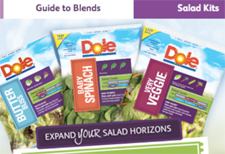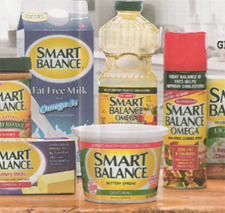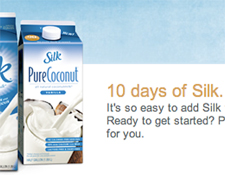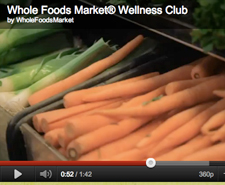This fall brought positive news for brands within the health and wellness category. Food and beverage companies with a higher percentage of sales from “Better-For-You” products have healthier businesses, according to an October report from the Hudson Institute, a nonpartisan policy research organization. In fact, during the five-year study period, BFY items drove more than 70% of sales growth.
That said, getting a product into the shopping cart is just the first step. Keeping consumers engaged in a healthy lifestyle is the key to ongoing success. That means going beyond the sale to provide the support that will help consumers stay the course.
Here’s how four forward-looking marketers are following through. In each example, the brand is using a specific program to hook consumer interest and provide a clear path to long-term health.
Dole “Salad Inspiration”
Dole’s program centers on its 10-week online “Salad Inspiration” competition, whi

ch challenges salad fans to use all the elements of fashion—patterns, textures, and colors—to create a stylish lettuce-based masterpiece.
The concept is carried through in-store, with an easy-to-use Salad Guide on Dole’s bagged salad line. Dole is also using mobile advertising to get consumers to think about salads more creatively and reinforce the on-pack info. At every point in the “Salad Inspiration” campaign, consumers are invited to engage and share ideas with other salad fans on social media sites.
For many consumers, salads are a “gateway food” to healthier eating. Dole’s promotion is simplifying that first step, and giving consumers ways to enjoy the variety of a greener diet, meal after meal.

Smart Balance “Blueprint”
Smart Balance is leveraging the heart-healthy benefits of its products—oils, spreads, beverages, and more—to promote a “Blueprint for Healthier Living.”
The Smart Balance 14-Day Menu Plan, available online and as a downloadable brochure, includes recipes, workouts, health information, and coupons. The plan is promoted in FSI’s and is the core of the brand’s online experience. The 14-Day concept not only helps the consumer maintain commitment, but also builds stronger ties to the specific brands recommended for the recipes, helping to make Smart Balance products staples in a healthier lifestyle.
Silk “Switch from Milk”
The mission of the “Silk for Milk 10-Day Challenge” is to persuade consumers to give up dairy milk and switch to soy, almond and coconut beverages instead, which is a huge hurdle in a milk-oriented country. Silk is tackling the problem in easy, practical steps that emphasize nutrition and taste.
 The program helps families find simple ways to substitute Silk for dairy (start with breakfast cereal, for example) while communicating the health benefits of plant-based beverages. All efforts lead to SwitchtoSilk.com where consumers find Silk’s10-Day Plan with nutrition information, environmental advantages, and more occasions for making the shift.
The program helps families find simple ways to substitute Silk for dairy (start with breakfast cereal, for example) while communicating the health benefits of plant-based beverages. All efforts lead to SwitchtoSilk.com where consumers find Silk’s10-Day Plan with nutrition information, environmental advantages, and more occasions for making the shift.
Changing a culturally ingrained behavior like drinking milk is no simple task. Silk’s challenge promotion, with all its supporting elements, combines boldness with the reassurance consumers need to make the transition to making drinking Silk an everyday habit.
Whole Foods Markets “Wellness Club”
Upscale Whole Foods stores are already Meccasfor the health-conscious. Now, the company is deepening and extending consumer engagement with a premium cache: “The Wellness Club.” Unlike typical engagement programs, the Wellness Club requires a significant financial commitment—a membership fee plus monthly dues. In return, consumers receive10% discounts at Whole Foods stores, a variety of classes and personal coaching sessions, supper clubs, cooking demos and guided shopping experiences.
Recognizing that their typical customer already has above-average awareness of healthy foods, Whole Foods is using this program to reach people who want to deepen their commitment, extending the Whole Foods brand into all aspects of the consumer’s healthy lifestyle and making them literally “part of the club.”
 The Hudson Institute study proves that good health is good business. Products once considered niche are going mainstream, and families in every demographic are becoming aware of the benefits of healthier eating.
The Hudson Institute study proves that good health is good business. Products once considered niche are going mainstream, and families in every demographic are becoming aware of the benefits of healthier eating.
For marketers, the first step is turning that awareness into action by stimulating purchase. Making the commitment last is the hard part, especially when a weak economy gives consumers an excuse to default to lower-priced, less healthy options. The future belongs to marketers like these who can provide the kind of support and information that builds and reinforces the consumer’s commitment to healthier eating, keeping them on track long after the initial promotion is over.
Fran Greenberg is senior vice president at Antidote 360, an integrated marketing agency focused exclusively on health and wellness marketing. She can be reached at greenberg@antidote360.com. Antidote 360 is part of Source Marketing, a PROMO 100 agency.



